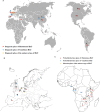Human African trypanosomiasis: the current situation in endemic regions and the risks for non-endemic regions from imported cases
- PMID: 32338232
- PMCID: PMC7391876
- DOI: 10.1017/S0031182020000645
Human African trypanosomiasis: the current situation in endemic regions and the risks for non-endemic regions from imported cases
Abstract
Human African trypanosomiasis (HAT) is caused by Trypanosoma brucei gambiense and Trypanosoma brucei rhodesiense and caused devastating epidemics during the 20th century. Due to effective control programs implemented in the last two decades, the number of reported cases has fallen to a historically low level. Although fewer than 977 cases were reported in 2018 in endemic countries, HAT is still a public health problem in endemic regions until it is completely eliminated. In addition, almost 150 confirmed HAT cases were reported in non-endemic countries in the last three decades. The majority of non-endemic HAT cases were reported in Europe, USA and South Africa, due to historical alliances, economic links or geographic proximity to disease-endemic countries. Furthermore, with the implementation of the 'Belt and Road' project, sporadic imported HAT cases have been reported in China as a warning sign of tropical diseases prevention. In this paper, we explore and interpret the data on HAT incidence and find no positive correlation between the number of HAT cases from endemic and non-endemic countries. This data will provide useful information for better understanding the imported cases of HAT globally in the post-elimination phase.
Keywords: Human African trypanosomiasis; T. b. rhodesiense; Trypanosoma brucei gambiense; non-endemic disease countries; sub-Saharan Africa.
Conflict of interest statement
We declare no competing interests.
Figures







References
-
- Barrett MP, Burchmore RJ, Stich A, Lazzari JO, Frasch AC, Cazzulo JJ and Krishna S (2003) The trypanosomiases. Lancet (London, England) 362, 1469–1480. - PubMed
-
- Büscher P, Cecchi G, Jamonneau V and Priotto G (2017) Human African trypanosomiasis. Lancet (London, England) 390, 2397–2409. - PubMed
-
- Büscher P, Bart JM, Boelaert M, Bucheton B, Cecchi G, Chitnis N, Courtin D, Figueiredo LM, Franco JR, Grébaut P, Hasker E, Ilboudo H, Jamonneau V, Koffi M, Lejon V, MacLeod A, Masumu J, Matovu E, Mattioli R, Noyes H, Picado A, Rock KS, Rotureau B, Simo G, Thévenon S, Trindade S, Truc P and Van Reet N (2018) Do cryptic reservoirs threaten Gambiense-sleeping sickness elimination? Trends in Parasitology 34, 197–207. - PMC - PubMed
Publication types
MeSH terms
LinkOut - more resources
Full Text Sources

